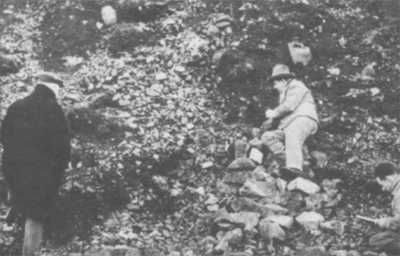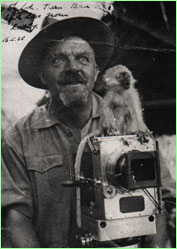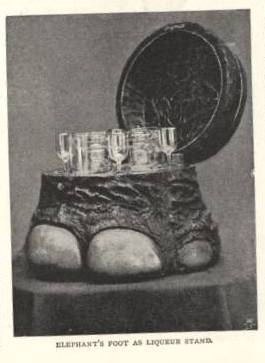Bring Forth The Track Cast of Nessie!
Posted by: Loren Coleman on December 25th, 2007
A few years ago, the cry across the land was to have the head of a Sea-Serpent brought to Science.
I place the same kind of call out there regarding the alleged track cast of the footprint of the Loch Ness Monster collected in December 1933, some 74 years ago.
Of course, we all take it to heart that the footprints found on the shores of Loch Ness were fakes made by Marmaduke Wetherell. But within cryptozoology, we must be skeptical in all directions. How many times have I heard about a “hoax” claim, especially with tracks, which has as many holes in it as the story it is suppose to be explaining?

Marmaduke Wetherell’s expedition found evidence of the Loch Ness Monster on land.
The Daily Mail headline was “Loch Ness Monster Is A Fact, Not A Legend,” in the newspaper of December 21, 1933.
A succession of smaller headlines told the story: “Hunter’s Deduction from New Find. Tracks Only A Few Hours Old. Tests To Be Made.”
The cause of all the excitement was two footprints in soft mud on the south shore of the loch near Fort Augustus. Marmaduke Wetherell had found them less than 48 hours after landing on the beach by motor boat. The “spoor” he declared was “less than a few hours old.”
The animal was an amphibian: “A four fingered beast . . . and it has feet or pads about eight inches across . . . a very powerful soft-footed animal about 20 ft long.”

Marmaduke Wetherell
Plaster casts were taken of the footprints and sent to the Natural History Museum. All through Christmas and New Year in 1934, the world waited for the museum’s verdict.
On January 4, 1934, it came. The footprints were identical, both seemingly from the same foot, and apparently from a young hippo. It was most likely that the foot was, in fact, in use somewhere as an umbrella stand or an ashtray.

The offending source of the alleged footprint hoax was imagined to look something like the above antique elephant stand.

A baby hippo foot (above) made into an ashtray, measuring 9 & 1/2″ high by 9″ wide at the base, by 6″ wide at the top. It was recently offered on eBay for over $500 US.
But where is the 1933 cast today? Wetherell reported finding the fresh footprints of a large, four-toed animal. What if he really found something, and the brush-off was brought on by the usual establishment stance of overturning anything unusual?
Wetherell estimated the unknown animal had to be 20 feet long (apparently from the stride?). With great fanfare, we are told, Wetherell made plaster casts of the footprints and, just before Christmas, sent them off to the Natural History Museum in London for analysis.

History records that the museum zoologists announced that the footprints were those of a hippopotamus. We have all heard the story so many times. But have you seen the actual close-up photos of the tracks or the authentic cast? Where are the photos and casts today?
It is time to call for these items from Christmastime 1933 to re-surface.
Bring forth the track cast of Nessie, my dear British Natural History Museum officials. Let us all re-examine the evidence for this hoax, and I, for one, would like to obtain copies of the 1933 cast.
I am not a fool. I expect to see evidence of a hippo ashtray. But I’d like to see it with my own eyes instead of reading about what others said it was, yet again.
About Loren Coleman
Loren Coleman is one of the world’s leading cryptozoologists, some say “the” leading living cryptozoologist. Certainly, he is acknowledged as the current living American researcher and writer who has most popularized cryptozoology in the late 20th and early 21st centuries.
Starting his fieldwork and investigations in 1960, after traveling and trekking extensively in pursuit of cryptozoological mysteries, Coleman began writing to share his experiences in 1969. An honorary member of Ivan T. Sanderson’s Society for the Investigation of the Unexplained in the 1970s, Coleman has been bestowed with similar honorary memberships of the North Idaho College Cryptozoology Club in 1983, and in subsequent years, that of the British Columbia Scientific Cryptozoology Club, CryptoSafari International, and other international organizations. He was also a Life Member and Benefactor of the International Society of Cryptozoology (now-defunct).
Loren Coleman’s daily blog, as a member of the Cryptomundo Team, served as an ongoing avenue of communication for the ever-growing body of cryptozoo news from 2005 through 2013. He returned as an infrequent contributor beginning Halloween week of 2015.
Coleman is the founder in 2003, and current director of the International Cryptozoology Museum in Portland, Maine.










How did he infer the length of the animal with only two prints? I guess there were more incomplete tracks not suitable for castings?
I’d like to see them too
Just last night (Sunday night) I saw one of the not so terribly old (about 3 or 4 years) shows about the Mysteries of Loch Ness. Among the various things brought up were the Weatherall footprints, of course. They also mentioned that ‘the only one who seemed surprised at this conclusion was Weatherall himself’. That’s not an exact quote, but I did find it interesting that they noted his surprise at being fobbed off so summarily. The newspaper didn’t even tell him they were canceling the rest of the project.
But I too agree, Loren. Let’s see the evidence, and see if a modern analysis agrees with the old one.
Loren: Merry Christmas to you and yours.
I think it is very important to collect all the evidence–even when it’s known to be hoaxed (and I know that that’s not quite the same thing as you’re describing here). When we can place data known to be false beside that which are still unexplained, the latter become even more glaringly in need of explanation (and the former become more obviously fake).
I think that cryptozoologists have, in the main, been very strict in their standards for what constitutes credible evidence; time and again I have seen them quick to be skeptical of new data (witness the recent discussion here regarding Jacob’s Creature). Generally speaking, I do not find that same level among the skeptics, who are either very quick to dismiss something outright or else refuse to even examine it. For example, Jeff Meldrum’s book has comprehensively presented some pretty strong points (dermal ridges and mid-tarsal ridges in footprint casts; ear-witness and sound recordings of vocalizations that fit the vocal patterns of no known animal; ape behavioral patterns that are consistent with the behavior of bigfoot in encounters with humans; data found in very remote places; etc., and some of this has obviously been discussed before). Any skeptic who does not address these points in a very thorough manner is no longer a part of the discussion.
A baby hippo made into an ashtray. Why do I frequently have such misanthropic feelings rush through me?
that baby hippo-ashtray and elephant-liquor stand are really fugly things 🙁
Skeptics believe that they enjoy the benefit of a less stringent standard of proof. The excuse for this is usually based on the assumption that they don’t have to prove anything because the burden of proof is on the “believers”. This of course is only true up to the point that the skeptics join the debate and start to offer their own theories.
I saw a lake monster program a few years back where an FBI forensic specialist was commenting on the Art Folden film of Ogopogo. Just what sort of expertise an FBI forensic specialist had to offer a discussion of Ogopogo was never revealed. Anyway, he was clearly stumped by the film. According to him it wasn’t faked. The object in it was large and it submerged and surfaced during the course of the film. Rather than just admit that he didn’t know what the object in the film was, he stated that in a few frames he saw what looked like a reflective shine on the object. As an amateur fisherman, he told us that he had seen shiny fish before and therefore the object in the film must be a school of shiny fish. Are you kidding? First, this guy was a forensic expert, not a fish expert. Second, no effort was made to either produce or recreate a film of shiny fish behaving like the object in the Folden film. This all suited the editors of course, as the program had a very obvious anti-lake monster position.
In another program I saw an “expert” from a natural history museum tell us that Nessie couldn’t be a plesiosaur because plesiosaurs were extinct. A nice bit of circular reasoning that would never be acceptable coming from a “believer”.
red_pill_junkie responds:
December 26th, 2007 at 12:01 am
that baby hippo-ashtray and elephant-liquor stand are really fugly things.
Couldn’t of said it better myself. Poor things. What is really sad, is these “were” two beautiful animals. And one was just a baby. What a shame.
I’d have to say that revisiting the casts and photos (don’t recall ever reading there were photos) won’t do much to change how they are viewed. It’s been revealed that Weatherall was behind the “Surgeon’s Photo” hoax, and the footprints were dismissed by scientists, so anything he touched is tainted, unfortunately. He was obviously looking for money and recognition.
The problem I have with alleged footprints should be an obvious one to everybody. I’m a man, and when I walk somewhere and leave footprints, I’ve never left one or two. How could a huge creature traverse an impressionable area and leave a lone print, maybe two? It’s just never made any sense to me. I’ve seen the same thing in documentaries about Bigfoot, etc., where we hear about an 800-pound creature that manages to leave behind a lone footprint. It seems to defy common sense.
“I’m a man, and when I walk somewhere and leave footprints, I’ve never left one or two. How could a huge creature traverse an impressionable area and leave a lone print, maybe two?”
Come on. Are you serious? Are you knowledgeable in woodcraft?
One or two prints are often left by animals when the terrain is not one that allows a trackway to be imprinted. Indeed, leaving no tracks are not out of the question.
For example, a rocky shore, icy covering, or water often interrupt the ability of feet to leave good tracks.
Do you leave tracks when you walk about on asphalt roads and concrete walks? Animals often pick the places they step or drag themselves so that tracks are not left so they will not be followed…and eaten.